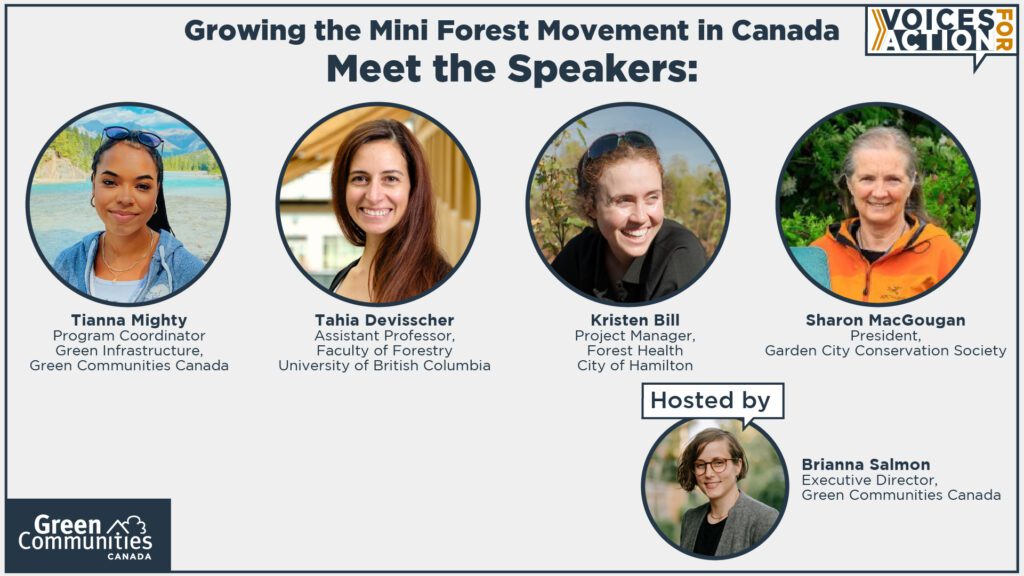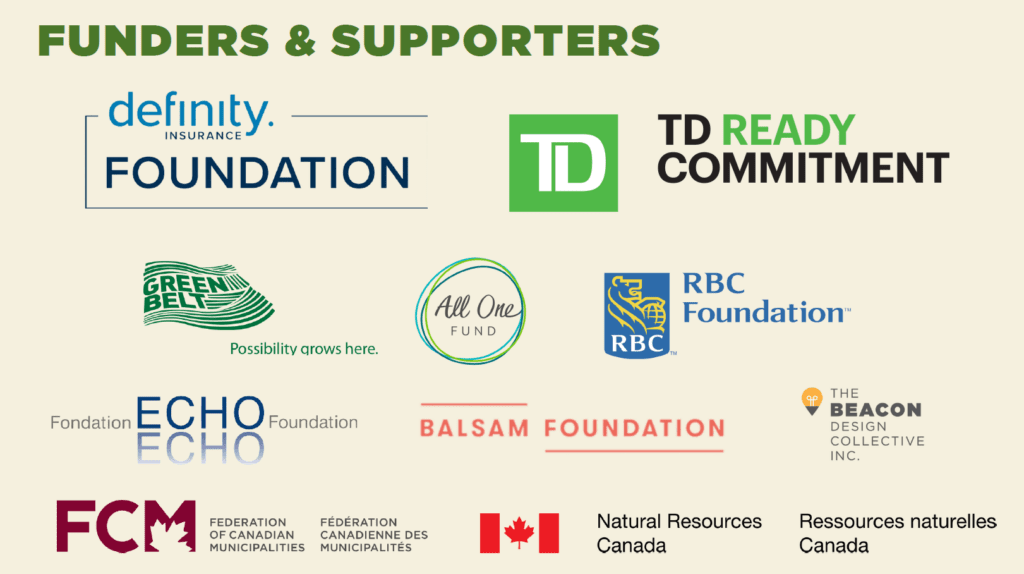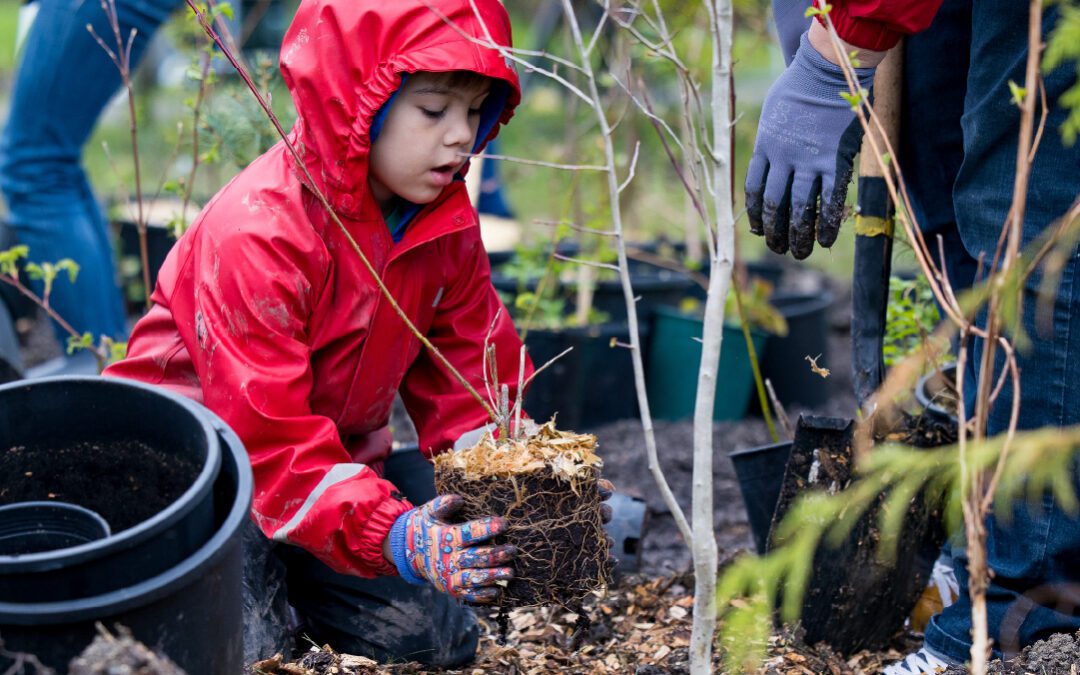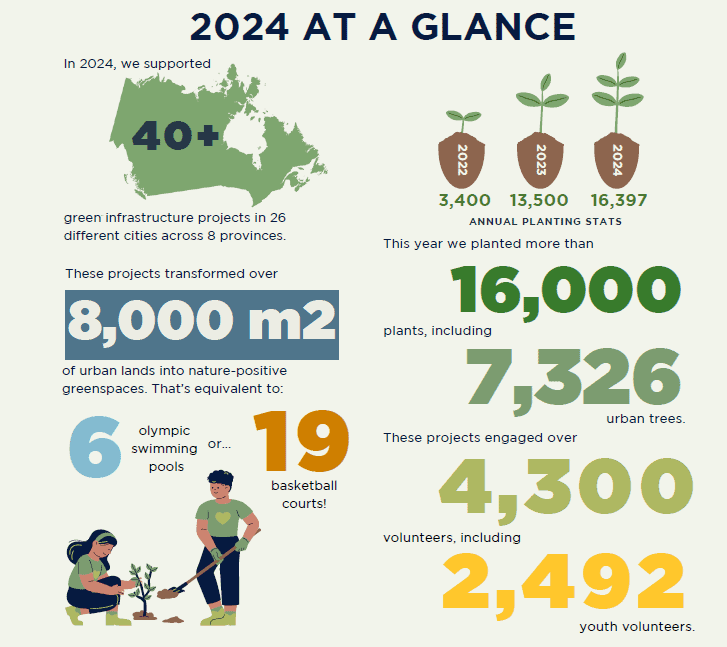In January, 2025, Green Communities Canada hosted our first Voices for Action webinar, on the topic of “Growing the Mini Forest Movement in Canada.”
You can watch the recording of this event here, and read a summary of highlights below. Resources mentioned in the presentations are available in a list at the bottom of this page, after this summary.
For more than a decade, Green Communities Canada has been leading Green Infrastructure projects like Mini Forests, Depave Paradise, Rain Gardens, and more. We are excited to release our Living Cities Canada Fund 2024 Impact Report. You can view the report here.
Highlights from Voices for Action: Growing the Mini Forest Movement in Canada

The January 2025 Voices for Action event featured Green Communities Canada’s own Tianna Mighty (Program Coordinator, Green Infrastructure), as well as Professor Tahia Devisscher (Assistant Professor, UBC Faculty of Forestry), Kristen Bill (Project Manager, Forest Health, City of Hamilton), and Sharon MacGougan (President, Garden City Conservation Society).
Patricia Stirbys and Peter Croal of the National Healing Forests Initiative provided a land acknowledgement and opened this event in a good way.
Professor Tahia Devisscher shared highlights from a study report that the University of British Columbia’s Faculty of Forestry will be completing and publishing in spring 2025. The study followed upon 15 mini forests supported by Green Communities Canada, conducting interviews and producing case studies to collect first-hand evidence and knowledge of the ecological and social benefits of these projects.
Preliminary findings suggest that mini forests are a particularly good fit for the Canadian context, especially in terms of municipal policies and implementations.
“Urban forest management is fragmented across Canada,” explained Prof. Devisscher. “Mini forests are multi-functional systems. They can be relevant to multiple policies at the same time.”
“In just the past two years, we have gathered a lot of evidence generated about the social benefits of mini forests,” shared Prof. Devisscher. These benefits include community building, intergenerational connections, youth engagement, connection to nature, environmental education, and both empowerment and stewardship.
“We have heard from participants that mini forests have become symbols of hope,” explained Prof. Devisscher, “that have helped local residents overcome ecological grief and build a sense of ownership and agency to do something about it.”
“It is really the existing mini forests that are the source of inspiration and fuel for this movement,” explained Prof. Devisscher. “This [movement] has also been enabled by the creation of a very open approach, which we observed in terms of resource sharing.”
Kristen Bill, Project Manager of Forest Health with the City of Hamilton, echoed Prof. Devisscher’s conclusions.
“We saw how well the trees grew,” Bill said. “It was really incredible. After witnessing how well trees are thriving in an area that is really poor for the plantings we typically do, [that] was kind of the kick starter for us in this movement.”
Bill’s presentation focused an ambitious Pritchard Trail Mini Forest project in 2024 in partnership with Green Communities Canada and the Greenbelt Foundation.
“The City of Hamilton has put forward an urban forest strategy,” explained Bill, “and planting is a major feature of that. This [Pritchard Trail Mini Forest] project has become a key part of that.”
Bill emphasized that this particular planting project had several key goals: work with existing natural features, provided habitat for wildlife, increase canopy coverage, and protect trail users from traffic noise from the nearby highways.
“The engaged partners were really a key piece,” explained Bill. “We did a Truth and Reconciliation Tree Planting event that took place in September. It was with Niwasa Kendaaswin Teg (which is a non-profit Indigenous youth organization). It provides high quality programs and services to the youth in Hamilton. They wanted to partner with the Hamilton Police Services and the city library.”
Bill shared that it was an amazing event that reduced barriers to participation, included an Indigenous knowledge keeper who did an opening ceremony, and started the project in a good way.
Bill emphasized that the success of the planting was because of tree selection, quality materials, and matching both with the site characteristics. More than those factors, though, Bill identified that volunteer engagement and outreach communication and coordination were key. Working with a local member organization from Green Communities Canada helped with these determinants of success.
“We partner with Green Venture,” Bill explained, “and they bring so much expertise in public communication. It is really amazing to partner with them [Green Venture] as a municipality.”
Bill recommended that municipalities partner with local environmental non-profit organizations to help extend their network and alleviate the pressure of advancing projects and managing planting events like this.
Sharon MacGougan, President of the Garden City Conservation Society, shared the inspirational story of how this volunteer-run society has grown over the years and achieved remarkable things together with the City of Richmond, B.C. The society began about 20 years ago with a group of citizen volunteers who vowed to save from development 136 acres of greenspace in the centre of the City of Richmond.
“This became a people’s movement,” explained MacGougan, “and when the lands were saved, it became the Garden City Conservation Society.” These lands became known as the Garden City Lands.
“In 2022, we read about the Miyawaki Method,” explained MacGougan. “It moved our hearts and minds. To date, our society has collaborated on five Miyawaki mini forests in Richmond.”
The most recent of these mini forests is planted on the Garden City Lands themselves with support from Green Communities Canada’s Living Cities Canada Fund.
“Conservation education and public engagement are powerful partners,” MacGougan emphasized, reinforcing the remarkable positive action that can come about when the public is engaged in planting events in their communities.
Resources List:
- Green Communities Canada’s Living Cities Canada Fund 2024 Impact Report. You can view the report here.
- UBC Faculty of Forestry 2024 study of 15 mini forest projects across Canada: to be published in Spring 2024 – make sure you subscribe to our monthly GC News for updates!
- Green Communities Canada offers a free, online asynchronous Mini Forest Course, available here: https://green-communities-canada.thinkific.com/
- Preliminary soil carbon findings from Vineland Research and Innovation: Vineland_Mini Forest Factsheet_Feb2024.pdf
- Green Communities Canada hosts a Mini Forest Community of Practice. Meetings are the third Thursday of the month. Contact Jenn McCallum to be added, jmccallum@greencommunitiescanada.org
- Living Cities Canada webpage
- National Mini Forest Pilot webpage
- Mini Forest Factsheet: https://www.vinelandresearch.com/wp-content/uploads/2020/02/Vineland_Mini-Forest-Factsheet_Feb2024.pdf
- City of Hamilton Urban Forest Strategy 2021
- Landowners Guide to Native Woody Species of Southcentral Ontario: https://fgca.net/wp-content/uploads/Spp_InfoTABLE_2021.pdf
- The bio-inoculant that Kristen Bill mentioned is Bacillus velezensis.

Green Communities Canada thanks the organizations that generously support our Living Cities Canada Fun, without whom this work would not be possible. TD Ready Commitment, Definity Foundation, Echo Foundation, Greenbelt Foundation, All One Fund, and the Beacon Design Collective Inc.


Recent Comments